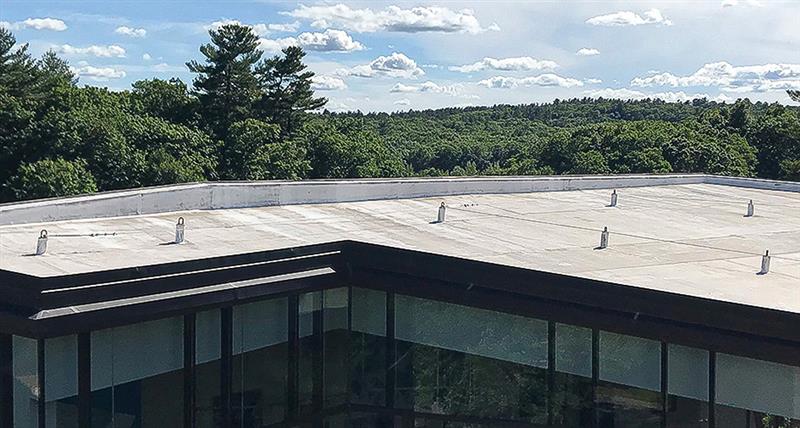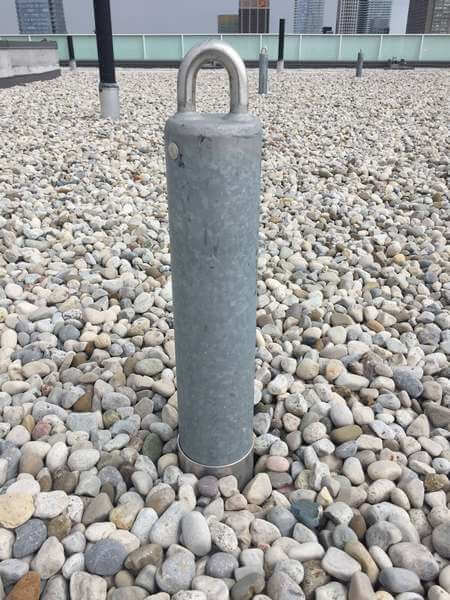A roof anchor is used as a point of suspension or securement for either a fall protection system (such as a horizontal lifeline system) or a fall arrest system (suspended access or window washing system). Roof anchors are made of either steel or aluminum, and the base is customized to be permanently installed into the rooftop’s structure.
Depending on their placement and purpose, roof anchors can be referred to by several different names, but they’re ultimately the same type of equipment.
Terms used for roof anchors are (but are not limited to):
Explore our roof anchors
Types of Roof Anchors

Permanent Roof Anchors
These are essential for securing fall protection equipment and ensuring safety when working at heights.
These anchor points are usually made from galvanized steel. They offer various mounting options, such as direct bolting, concrete casting, and welding, and are welded to the embedded plates to suit your building’s structure.
- Vertical Steel Pier Anchors: The most commonly used anchor is the vertical steel pier anchor. The various models are differentiated by their bases and customized based on the roof’s structure. These anchors can be used for window washing, suspended maintenance, and rooftop fall protection.
- U-Bar Anchors: Several models of U-bars range from a simple metal bar welded into a “U” shape to a full anchor with reinforcing beams. The actual tie-off (or anchorage point) usually varies. Some companies utilize a swivel, head U-bar that points horizontally (perpendicular) to the pier and can swivel, while others have fixed “U-bars” or “eyelets.” These points are vertical. They are shorter than their pier counterparts and are typically used for rooftop fall protection systems.
Soffit Anchors
This refers to a permanent roof anchor installed on the underside of a structure, such as under a balcony, terrace, overhang, or the titular soffit.
Fall Arrest Anchors
A fall arrest anchor is another term for a roof anchor, but it explicitly refers to anchor points used for suspension lines for window washers or other facade maintenance personnel.
Wall Anchors
Wall anchor models are different from standard roof anchor models. As the name suggests, wall anchors are usually installed into the side of a wall and are typically used for fall protection systems.
Fabricated Posts
Fabricated posts are available in single-point, intermediate, end, or corner anchorage, and in a range of heights. They are easy to install and require low maintenance, making them joint investments. Mounting options are customizable, including welding posts with no base plate, backer plates, direct bolting, welding options, or even casting into concrete.
Designing & Installing Roof Anchors
Designing roof anchors involves several key considerations to ensure they provide adequate safety and functionality. Essential factors include understanding the design's intent, whether it's to protect facade maintenance workers suspended off lines or to act as a tie-back anchor for rooftop workers.
Pro-Bel offers a free design service for the roof anchor
Properly designing roof anchors ensures they comply with safety standards and provide reliable fall protection. Our comprehensive Roof Anchor Design and Installation Guide offers a detailed overview of designing, manufacturing, and installing roof anchors.
The design rule is that 5,000 pounds (2,267.96 kilograms) fracture or pull-out is sufficient to accept all tie-back and lifeline loads that will likely be subjected to the anchor using conventional equipment on a rooftop.
The codes state that the 5,000 pounds (2,267.96 kilograms) is based on a worker’s weight of 250 pounds (113.4 kilograms), experiencing a force of gravity multiplied by ten times a safety factor of 2.
Where to Use Roof Anchors
Applications and Benefits of Roof Anchors
Roof tieback anchors are used in various applications. They are typically installed in commercial, office, apartment, or mixed-use buildings with a significant drop distance and a parapet under 42 inches. They protect rooftop workers and save the building owners from liability by preventing accidents.
Roof anchors can be used solely for fall protection or a combination of fall protection and suspended access.
Using Anchors in a Fall Arrest System
A fall arrest system refers to the safety lines used in suspended access systems that catch workers who descend a building’s facade in the event of an accident. Roof anchors are installed at an offset angle behind the primary suspension equipment, including pier anchors, davits, outrigger beams, and other similar components. Before lowering themselves, facade maintenance workers connect their harnesses to the anchors via a cable.
Window Washing Anchors
Window washers can utilize tie-back anchors to suspend themselves adjacent to the building facade and perform window-washing operations. This is commonly done in a bosun’s chair but can also be performed on a single-cage platform.
These anchor points are laid out to access all windows on a building’s facade or the entire facade, as specified. Suppose the drop distance is over 300ft (90m) tall or has architectural features that a standard roof anchor can’t accommodate. In that case, an alternative system will be implemented, such as window washing davits, outrigger beams, rigging sleeves, and so on. When Davit systems host the suspension lines, roof anchors are usually installed at an offset angle behind them to host the lifelines.
Contact our experts to find and install the ideal roof anchor for your building's specific requirements.
Facade Maintenance
When a building requires facade maintenance on more than just its windows—the total facade or certain parts—the anchor layout must accommodate this. The reasons for needing total facade access can vary, including restoring brickwork, applying window caulking, repairing balconies, maintaining exterior signs, or performing any other facade work that would require suspension. The systems installed on the roof utilize specialized platforms, referred to as swing stages, to allow workers to access elevated areas efficiently.
If you're working with reinforced concrete, our article on Roof Anchor Protection on Reinforced Concrete might be helpful.
How to Use Roof Anchors
Proper Use and Inspection
When you ensure you are correctly attached and secured to the system, your equipment must be thoroughly checked and examined before dropping off the ledge. Inspecting your gear and equipment for faults or tears will help ensure the anchor keeps you secured while working, as this line takes your weight and keeps you close to the wall. It is crucial to verify the installation correctly to ensure confidence that you are within all weight limitations and that all elements are properly secured.
If you are still unsure how to use a tie-back anchor properly, we offer installation and inspection services for roof anchors to ensure peace of mind that your workplace is compliant.
What Methods Are Available
Rope Descent Roof Anchorage Systems
Roof anchors can support suspension lines and lifelines for facade maintenance personnel in buildings with a drop distance of under 300 ft (90m).
Horizontal Lifeline Systems
A more comprehensive fall protection approach involves a horizontal lifeline system (HLL). A HLL horizontal lifeline system refers to a fall protection layout that strategically places permanent roof anchors so that when a rooftop worker attaches to the cable, there is no risk of falling from the edge. The permanent roof anchors are set 6 feet from the roof edge and designed for a horizontal lifeline cable to run through them.
Choosing Simplicity in Fall Protection
Why Simple Solutions Are Effective
Different fall protection companies worldwide refer to roof anchors differently; there is no concrete definition as it varies from company to company. The varying vocabulary is a byproduct of fall protection, a niche industry where terminology can’t be learned in school but only through hands-on experience.
For code-compliant and fully engineered solutions, visit our Permanent Roof Anchor Systems, featuring downloadable brochures and expert design support.
The most straightforward approach is often the best; window washing, suspended maintenance, and fall protection systems are no exception. To ensure a safe work environment for rooftop workers, it's essential to maintain and inspect roof anchors regularly. Safety measures are crucial in any industry where workers operate at heights. Combining practical solutions with proper training can create a safer work environment for everyone involved.
Share this Post

